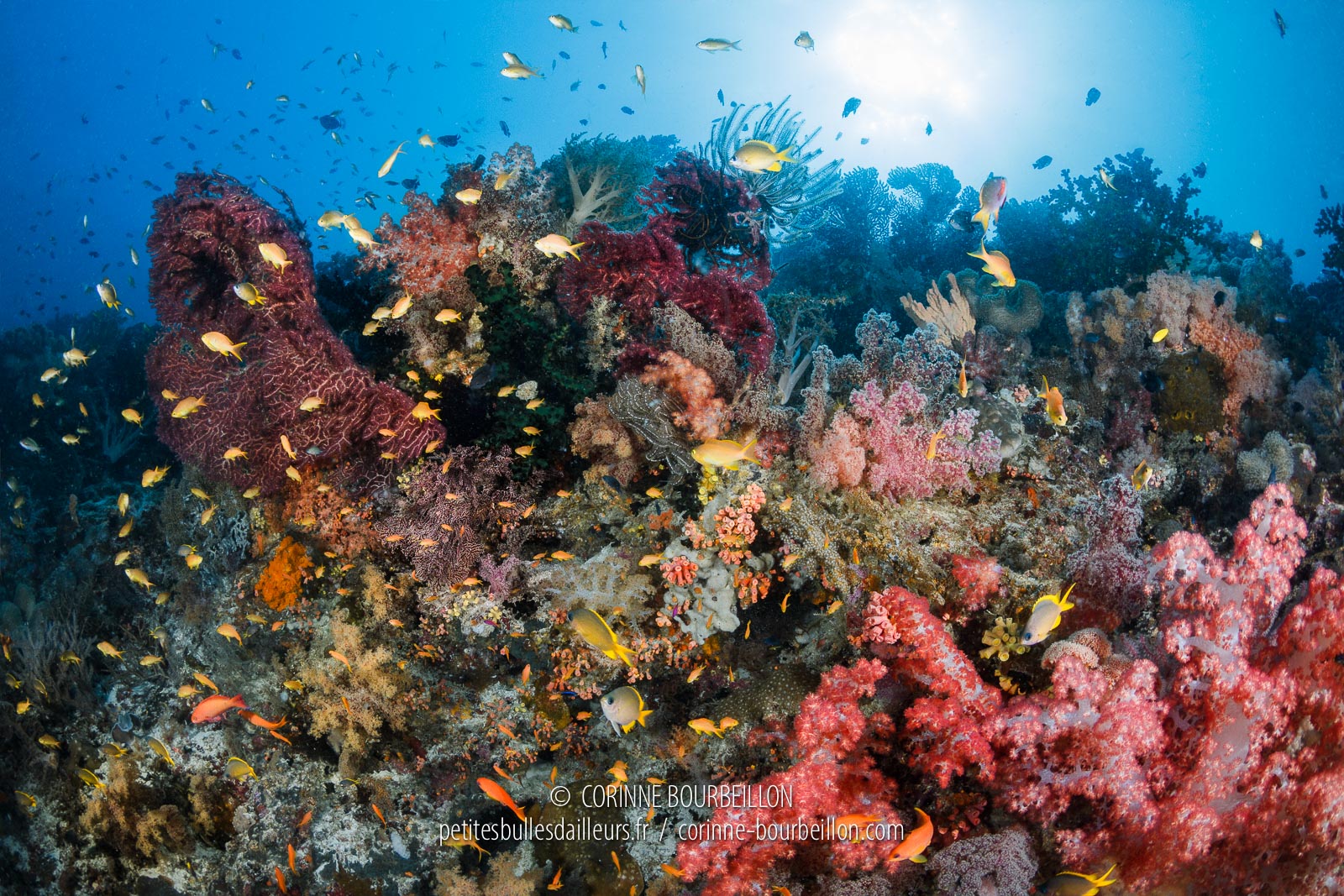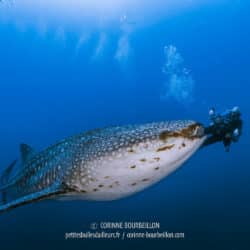Philippines: Cabilao + Balicasag [Panglao-Bohol] - February-March 2019
Dear English-speaking readers, this page is an automatic translation of an article originally written in French. I apologise for any strange sentences and funny mistakes that may have resulted. If you read French, click on the French flag below to access the original, correct text:
To make bubbles along coral reefs overflowing with life and colors, what happiness! In the Philippines, the island of Cabilao is a real little underwater jewel.
Cabilao, a quiet little island
I bring you back in February 2019, to the Philippines. For this diving trip, I only have two weeks in front of me and I decided to dedicate the first one to Cabilao, which has been on my mind for many years...
Cabilao is a very small island of less than 8 square kilometers. Triangular in shape, it is located on the northwest coast of Bohol, in the Cebu Strait. It is here:

Cabilao has five villages and less than 5,000 inhabitants, living mainly from fishing, agriculture and tourism. Unlike other islands near Bohol, it is not connected by a bridge, so the place has remained quite quiet.
It has a peaceful atmosphere that contrasts with the tourist frenzy of Alona Beach on Panglao, not far from there, which made me run away during my very first stay in the Philippines in 2008…
Apart from diving, there is not much to do on Cabilao... There is a large inland lake that can be explored, lots of small roads where it is easy to ride a scooter, some tourist accommodations and a handful of diving resorts.
This is the perfect island to break away from the hustle and bustle of the world... 👌


Above: one of the small roads of Cabilao, easy to travel by scooter. At the small port of Talisai, on the southeast coast, we are greeted by the Ten Commandments. (Philippines, February 2019)




Diving without too many divers around...
After browsing the internet and reading reviews on diving forums (I will often rummage on Plongeur.com and Scubaboard.com to prepare my stays), I opted for the Cabilao Sanctuary and its diving center Miscellaneous Cabilao (located right next to another resort often favorably recommended too, the Polaris).
I'm glad I went with the former (and I don't have any shares in them).
I discover that the clientele there is rather family oriented, so there are few divers as keen as me (understand: chaining three dives per day). We are therefore very few on the boat for exploration trips (most of the other customers are doing baptisms or training) and consequently always in very small committee underwater... 👌
For a photographer like me (understand: who can't stand big groups that scare away the fishes), it is ideal. I must admit that I enjoyed watching, from a distance, the groups of divers that were piling up every morning on the boats of the nearby resort.
Two very nice young French instructors managed the Cabilao Divers center during my stay. They understand my expectations very well and I appreciate the way they organize the outings: choice of sites almost à la carte from day to day (depending on the conditions), small groups divided by level... And, regularly, I have one of the Filipino guides, who knows perfectly the Cabilao reefs, all to myself. The absolute luxury in my eyes! 🤗
As for the rest, everything is fine too. There are rooms for all budgets, a nice little pool for post-dive desalination, a nice terrace facing the sea to admire the setting sun and the staff is adorable. A detail that does not spoil anything: the management is French, so the food served in the restaurant is pleasant.




My "home" for the week, a simple bungalow... (Cabilao, Philippines, February 2019)
At night, the hermit crabs are on the prowl and the geckos have eyes bigger than their stomachs... (Cabilao, Philippines, February 2019)
Coral in great shape
Frankly, I was expecting at least "nice" dives in Cabilao, but I quickly realized that we are definitely a step above...
From the very first dive, at the aptly named Gorgonian Wall, I was won over. 😲 There is something exhilarating and moving at the same time to contemplate such a beautiful underwater landscape. I would almost shed a little tear in my mask...
The good health of the coral, exuberant, varied, dense, is so pleasing to see!
For wide-angle atmospheric photosI discovered with wonder huge orange and pink gorgonians, huge tables of Acropora, purple and yellow soft corals in profusion, impressive barrel sponges... And at each dive, or almost, we met one or several turtles! Day after day, I am subjugated by the coral reefs of Cabilao. In front of these vertical walls overflowing with life, the most delicate thing to manage is the sunlight for underwater pictures, because this one is not always positioned at the ideal place - depending on the orientation of the sites, the time of the day, the direction of the current... Yes, I have big problems in life... 😂
Macro photo sideThe small fauna usual in these latitudes presents here a rich diversity of species, whether you are bitten by nudibranchs (sea slugs), pygmy seahorses, antennae (also called toadfish or frogfish), delicate ghost pipefish or hideous scorpionfish... 😍 Impossible to get bored! Besides the drop-offs, there are also some sites more oriented "muck-dive" oriented sites (where you can look for small fauna hiding in the substrate) on a sandy bottom, with seagrass beds and coral rubble.
Below is a small selection of images, which give a good idea of what you can expect while diving in Cabilao.

Along the drop offs, you can admire imposing gorgonians, pink, yellow and orange... (Cabilao, Philippines, February 2019)
Gorgonians addict... (Cabilao, Philippines, February 2019)






A cute bargibanti pygmy seahorse, clinging to its gorgonian branch with purple polyps and a denise pygmy seahorse. (Cabilao, Philippines, February 2019) Read also → Shy as a pygmy seahorse
The golden apogon, mouth closed then open, revealing its eggs that it incubates in its mouth... This is called oral incubation. (Cabilao, Philippines, February 2019)
Above, close-up portrait of a scorpion fish, and a nudibranch (sea slug) that thinks it is a bull... (Cabilao, Philippines, February 2019)


As for hammerhead sharks that used to evolve in the waters of Cabilao (and that some diving tour operators still dare to mention or even to put in pictures, to lure the client), don't hope to see them. They were massively fished in 1999-2000 and their population never recovered. Besides, I did not see any big fish in the area...
The Cabilao sites therefore have everything to please Zen and contemplative diversThis is a place where you will find the most beautiful corals and a lot of strange and fascinating little animals, but it is clearly not a place for "big" divers (even if, as in Balicasag, not far from there, it is a place where you will find the most beautiful corals). But it is clearly not a place for "big fish" lovers (even if, like in Balicasag, not far from there, we are not safe from meeting by chance a big whale-shark passing by).
Marine protected areas
Good to know: you have to pay a small daily fee to be able to dive in Cabilao, because the island has two marine protected areas (MPAs). A chance for the coral and the fish of the area. It is undoubtedly thanks to them that the reefs have remained so beautiful...
MPAs are indeed very effective in preserving or regenerating a local underwater ecosystem, whether in Asia or the Mediterranean. In addition, they benefit the neighboring waters, helping them to repopulate, to enrich in species and biomass: it is the "reserve effect". This is the "reserve effect", which gives nature a real boost!
Unfortunately, this remains a drop in the ocean, compared to the three very destructive practices, unfortunately well known in Asia, which are dynamite fishing, industrial fishing and shark fin fishing…
Dynamite fishing. In Asia in particular, dynamite fishing has destroyed many reefs in a few decades. Although it is now illegal and very dangerous, it is still practiced in some areas near the coral reefs. It happened to me several times, in Indonesia and in the Philippines, in particular, to hear explosions under water, during dives... Terrifying. The sound propagates underwater without being able to identify the direction or the distance.
Industrial fishing. On the high seas, these are the factory ships of industrial fishingThey continue to drain the ocean, depleting fish stocks that cannot be replenished. They continue to literally drain the ocean, depleting fish stocks that cannot be replenished, not to mention their countless so-called "by-catches" (dolphins, turtles, and other commercially unfit species).
Shark finning. Finally, there is also the juicy shark-finningi.e. shark fin fishingThis is disastrous for shark populations, which are predators that are essential to the balance of marine ecosystems... An ocean without sharks is a threat to life on land.
On my modest scale of tourist diver, I had the chance to discover many protected sites, reserves and marine parks, offering magnificently preserved reefs full of life. In Cabilao, as well as in Tubbataha and Balicasag in the Philippines, but also in Sipadan in Malaysia, at Komodo and Raja Ampat in Indonesia...
On divers' or travelers' forums, I sometimes read comments from people who are outraged to have to pay a tax to access some of these marine protected areas, in Asia or elsewhere - some of them even congratulating themselves for having managed to avoid paying it...
Nothing to brag about. Part of the money collected is used to involve local people in the conservation of their environment and fishery resources. But awareness and good will are not enough. Without financial means, it is impossible to protect a maritime area from poaching, concreting, overexploitation or pollution...
My previous diving trips to the Philippines
After Cabilao, I chose to stay in the area and to devote the second part of my stay to dive sites accessible by day from Panglao: in particular the island of Balicasag and the sumptuous reef of Doljo. I'll tell you about it in future posts...
This stay from February-March 2019 is already my fifth trip to Philippines. As I often write to those who ask me for itinerary advices, it is impossible to discover the multiple facets of this huge archipelago and its countless diving sites in one go... You have to make choices. To inspire you, here are my previous trips:
- In February 2008: discovery of the Visayas (Leyte, Panglao-Bohol, Siquijor, Negros, via Cebu).
- In March 2017: Anilao and Romblon, two paradises for macro.
- In February 2018: Pangatalan Island, near Palawan, to discover the environmental restoration work of the Sulubaaï foundation, aboard the oceanographic schooner Tarain the context of a report for my newspaper, the daily Ouest-France, and for the dive magazine Dive!
- In May 2018: cruise to Tubbataha, followed by a few days of diving in Balicasag. (Panglao-Bohol), two marine reserves.
Philippines: Cabilao + Balicasag [Panglao-Bohol] - February-March 2019



























